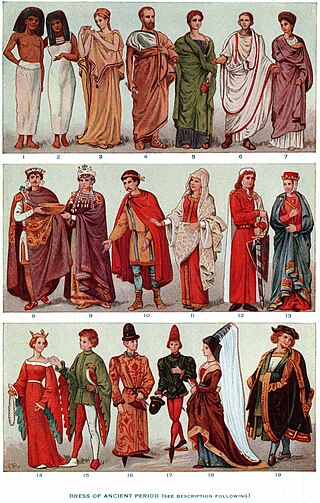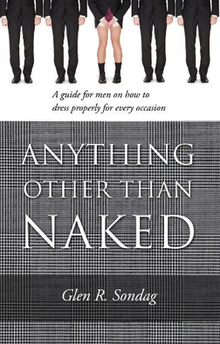
Fashion is a term used interchangeably to describe the creation of clothing, footwear, accessories, cosmetics, and jewellery of different cultural aesthetics and their mix and match into outfits that depict distinctive ways of dressing as signifiers of social status, self-expression, and group belonging. As a multifaceted term, fashion describes an industry, styles, aesthetics, and trends.

The kimono is a traditional Japanese garment and the national dress of Japan. The kimono is a wrapped-front garment with square sleeves and a rectangular body, and is worn left side wrapped over right, unless the wearer is deceased. The kimono is traditionally worn with a broad sash, called an obi, and is commonly worn with accessories such as zōri sandals and tabi socks.

Clothing is any item worn on the body. Typically, clothing is made of fabrics or textiles, but over time it has included garments made from animal skin and other thin sheets of materials and natural products found in the environment, put together. The wearing of clothing is mostly restricted to human beings and is a feature of all human societies. The amount and type of clothing worn depends on gender, body type, social factors, and geographic considerations. Garments cover the body, footwear covers the feet, gloves cover the hands, while hats and headgear cover the head, and underwear covers the private parts.

Black tie is a semi-formal Western dress code for evening events, originating in British and American conventions for attire in the 19th century. In British English, the dress code is often referred to synecdochically by its principal element for men, the dinner suit or dinner jacket. In American English, the equivalent term tuxedo is common. The dinner suit is a black, midnight blue or white two- or three-piece suit, distinguished by satin or grosgrain jacket lapels and similar stripes along the outseam of the trousers. It is worn with a white dress shirt with standing or turndown collar and link cuffs, a black bow tie, typically an evening waistcoat or a cummerbund, and black patent leather dress shoes or court pumps. Accessories may include a semi-formal homburg, bowler, or boater hat. For women, an evening gown or other fashionable evening attire may be worn.

Rubber fetishism, or latex fetishism, is the fetishistic attraction to people wearing latex clothing or, in certain cases, to the garments themselves. PVC fetishism is closely related to rubber fetishism, with the former referring to shiny clothes made of the synthetic plastic polyvinyl chloride (PVC) and the latter referring to clothes made of rubber, which is generally thicker, less shiny, and more matte than latex. PVC is sometimes confused with the similarly shiny patent leather, which is also a fetish material. Latex or rubber fetishists sometimes refer to themselves as "rubberists". Gay male rubberists tend to call themselves "rubbermen".

A suit, lounge suit, or business suit is a set of clothes comprising a suit jacket and trousers of identical textiles worn with a collared dress shirt, necktie, and dress shoes. A skirt suit is similar, but with a matching skirt instead of trousers. It is considered informal wear in Western dress codes. The lounge suit originated in 19th-century Britain as a more casual alternative for sportswear and British country clothing, with roots in early modern Western Europe. After replacing the black frock coat in the early 20th century as regular daywear, a sober one-colored suit became known as a lounge suit.
Clothing terminology comprises the names of individual garments and classes of garments, as well as the specialized vocabularies of the trades that have designed, manufactured, marketed and sold clothing over hundreds of years.
Semi-formal wear or half dress is a grouping of dress codes indicating the sort of clothes worn to events with a level of formality between informal wear and formal wear. In the modern era, the typical interpretation for men is black tie for evening wear and black lounge suit for day wear, corresponded by either a pant suit or an evening gown for women.

Children's clothing or kids' clothing is clothing for children who have not yet grown to full height. Children's clothing is often more casual than adult clothing, fit for play and rest.

Smart casual is an ambiguously defined Western dress code that is generally considered casual wear but with smart components of a proper lounge suit from traditional informal wear. For men, this interpretation typically includes dress shirt, necktie, trousers, and dress shoes, possibly worn with an odd-coloured blazer or a sports coat.

Fashion of the 1980s was characterized by a rejection of 1970s fashion. Punk fashion began as a reaction against both the hippie movement of the past decades and the materialist values of the current decade. The first half of the decade was relatively tame in comparison to the second half, which was when apparel became very bright and vivid in appearance.

Fashion of the 1960s featured a number of diverse trends, as part of a decade that broke many fashion traditions, adopted new cultures, and launched a new age of social movements. Around the middle of the decade, fashions arising from small pockets of young people in a few urban centers received large amounts of media publicity, and began to heavily influence both the haute couture of elite designers and the mass-market manufacturers. Examples include the mini skirt, culottes, go-go boots, and more experimental fashions, less often seen on the street, such as curved PVC dresses and other PVC clothes.

Fashion in the 1970s was about individuality. In the early 1970s, Vogue proclaimed "There are no rules in the fashion game now" due to overproduction flooding the market with cheap synthetic clothing. Common items included mini skirts, bell-bottoms popularized by hippies, vintage clothing from the 1950s and earlier, and the androgynous glam rock and disco styles that introduced platform shoes, bright colors, glitter, and satin.
Western dress codes are a set of dress codes detailing what clothes are worn for what occasion. Conversely, since most cultures have intuitively applied some level equivalent to the more formal Western dress code traditions, these dress codes are simply a versatile framework, open to amalgamation of international and local customs. This versatility has made this scale of formality a practical international formality scale.

The most characteristic North American fashion trend from the 1930s to 1945 was attention at the shoulder, with butterfly sleeves and banjo sleeves, and exaggerated shoulder pads for both men and women by the 1940s. The period also saw the first widespread use of man-made fibers, especially rayon for dresses and viscose for linings and lingerie, and synthetic nylon stockings. The zipper became widely used. These essentially U.S. developments were echoed, in varying degrees, in Britain and Europe. Suntans became fashionable in the early 1930s, along with travel to the resorts along the Mediterranean, in the Bahamas, and on the east coast of Florida where one can acquire a tan, leading to new categories of clothes: white dinner jackets for men and beach pajamas, halter tops, and bare midriffs for women.
Born in the second half of the 1970s and developed in the 1980s, power dressing is a fashion style that enables women to establish their authority in a professional and political environment traditionally dominated by men.

Fashion design is the art of applying design, aesthetics, clothing construction and natural beauty to clothing and its accessories. It is influenced by culture and different trends, and has varied over time and place. "A fashion designer creates clothing, including dresses, suits, pants, and skirts, and accessories like shoes and handbags, for consumers. He or she can specialize in clothing, accessory, or jewelry design, or may work in more than one of these areas."

Many stylistic variations of the bikini have been created. A regular bikini is a two-piece swimsuit that together covers the wearer's crotch, buttocks, and breasts. Some bikini designs cover larger portions of the wearer's body while other designs provide minimal coverage. Topless variants are still sometimes considered bikinis, although they are technically not a two-piece swimsuit.

Bonobos is an e-commerce-driven apparel company that designs and sells menswear including men's suits, trousers, denim, shirts, shorts, swimwear, outerwear, and accessories. The company was founded by Stanford Business School students Andy Dunn and Brian Spaly, and launched as an online retailer in 2007.

John Michael Ingram was an influential British menswear designer and retailer of the 1950s and '60s who founded the John Michael fashion brand, followed by a range of successful retail concepts, before establishing one of the first fashion forecasting agencies in the 1970s.
















